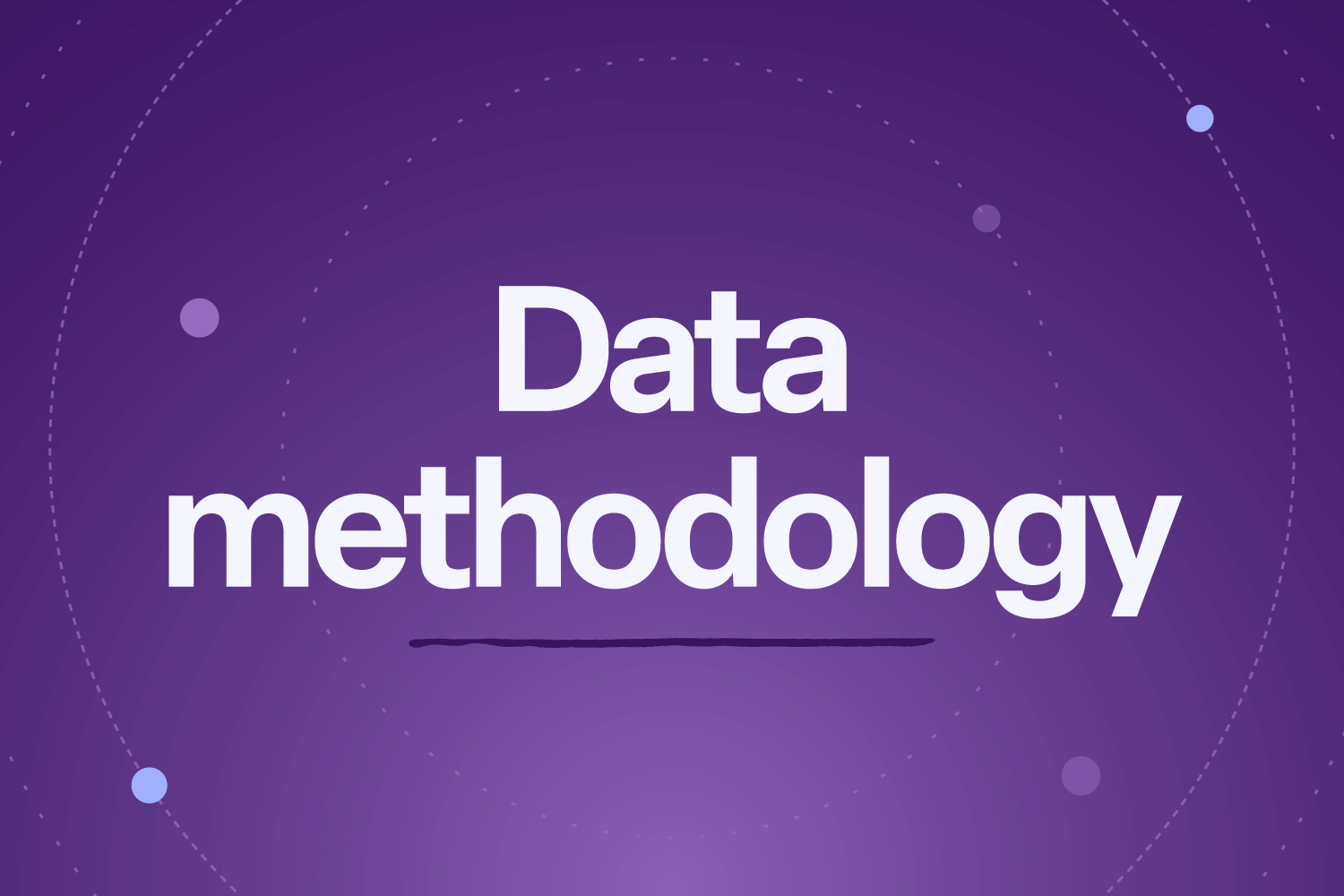Methodology: Bonterra 2025 Impact Report

In the spirit of data transparency, we’ve provided a detailed methodology for the six key sections of the Bonterra 2025 Impact Report, focusing specifically on our unique findings. We hope these insights help to build trust with our customers and promote data best practices across the industry.
1. Convert prospects into champions
Invest in email.
Each email link clicked generates an average of $39 in donations.
Methodology: We pulled the data about the emails each organization sent. We trained a linear regression model, which gives a number to indicate on average how much a change in the x-value corresponds to a change in the y-value. In our case, we found that each email link clicked corresponded to an average of $39 in donations.
Pick your moment.
Nonprofits see higher engagement when emails are sent mid-morning on Tuesdays and Thursdays; avoid weekends and late evenings to improve open rates; 25-30% is a benchmark open rate for nonprofits to aim for or above.
In your initial outreach, ask a supporter to become a recurring donor. While on average 7% of supporters will opt in at that moment, this pool accounts for 78% of an organization’s total recurring donors on average — making it a crucial opportunity for conversion that you can attain from the start.
Methodology (for both): We pulled data for all EveryAction committees that met certain panel inclusion criteria such as being a client for the past three years with normal growth curves. Then we looked at their donors and defined a recurring donor as someone who had given at least two recurring gifts. Then we looked at the donations for all donors and calculated the conversion rates by gift number.
Don’t wait to ask again.
First-time donors are more likely to give again if you re-engage within the first two months. Just make sure you highlight the impact of their first gift and thank them before asking for continued support.
Methodology: We used the same EveryAction committees that met certain inclusion criteria such as being a client for the past three years with normal growth curves. Then for each donor, we labeled their gift with a gift number. Then for all gifts with a gift number of two, we attached the time since the last gift. Taking the average of this number gives us the average time between gifts. This showed that roughly 50% gave again within two months.
Persistence pays off.
Donors who give second gifts are nearly 5x times more likely to become sustained donors.
Methodology: Using the same panel from above, we took the subset of donors who gave second gifts and then calculated how many of them became or eventually became recurring donors. The ratio of that value to the likelihood of any donor whatsoever becoming a sustainer is about 5x.
Increase your ask from sustained donors every time.
Sustained donors are willing to increase giving by approximately 1.5% every ask. Find creative ways to thank them for their increased support and incorporate additional, thoughtful asks along the journey.
Methodology: We labeled by the gift number over donations and calculated the average gift amount within gift number groups. This showed that each additional gift yielded an increase at each step by about 1.5% on average.
Don’t give up on non-responders.
The cyclicality of donors varies, with an average of 270 days between gifts. While a large majority of donors give on an almost yearly basis, about 20% of donors give beyond that annual cadence. It’s important to reach out beyond the annual cycle and include that group of supporters.
Methodology: This is based on the full spread of time between gifts. We created a cumulative chart of the proportion of donors who have given again on each day out from the last gift. This allowed us to read off what percentage of donors will have typically given on day X from the last gift.
2. Finding your ideal funding match
Make multiple applications.
Nonprofits that apply for more grants receive more funds on average, even if they also receive several rejections.
If you think it’s the right fit, don’t give up after rejection.
63% of nonprofits give up after one rejection. But on average, it takes 1.24 applications to receive funding.
Go back to the well.
Overall, 52% of nonprofits that reapply to the same funder or apply to a different funder receive funding.
Applied to the same funder again – 34.7%
Approved by the same funder – 49.13%
Applied to a new funder – 4.99%
Approved by a new funder – 63.74%
Try more, smaller requests.
Nonprofits that apply to multiple smaller grants end up receiving more funds on average than nonprofits that apply to one larger grant.
Methodology (applies to all): We analyzed grant applications that organizations made to funders from 2023-24. For each organization-funder pair, we collected information such as the amount granted and the number of applications, rejections, and approvals. We excluded outlier pairs in which an org made more than 100 applications to the same funder, indicating that there was something anomalous with the org or the data. Next, we investigated if orgs applied to the same funder or a new funder after being rejected. We also calculated how often orgs that applied after rejection were approved by the same or a new funder.
3. Respond to crises in record time
Start fundraising early.
In the case where a crisis or significant cultural moment is predicted (e.g., a hurricane hitting a coast or a judgment from the Supreme Court being delivered), nonprofits that start fundraising ahead of time often experience a surge in donations up to one day before and three days after.
Based on data in response to 2022-23 hurricanes, nonprofits experience an average 1,308% surge in funding the week before and up to three days after the storm — so it pays to ask for larger amounts immediately, and more regularly.
Be ready to focus locally.
Based on data analysis of the Dobbs ruling in 2022, local organizations experienced an average 2,105% increase in total donations around the leak date and an average 5,170% increase around the Supreme Court decision.
Prepare for new donors.
Nonprofits see an average 1,735% increase in new donors at the peak of a natural disaster due to a dramatic lowering of trust barriers and increased need. In the two weeks after the murder of George Floyd in 2020, Black Lives Matter (BLM) and aligned organizations attracted over 400,000 new donors.
Expect big surges for social crises.
Local nonprofits saw an average 5,170% increase in total donations per day around the Dobbs decision date by the Supreme Court. Similarly, nonprofits aligned to racial equity saw an average 7,190% surge in the total amount of donations when major social justice milestones occurred in 2020, compared to regular days.
Methodology (applies to all): We analyzed donation data surrounding hurricanes in 2022-23 and social movements relating to Black Lives Matter (2020) and the Dobbs ruling (2022). To identify surges in data, we excluded outlier donations above $1,000. Surges were periods of increased giving directly before or after the event. We calculated the percent increase in giving and in the number of new donors between the surge days and regular, non-surge days.
4. Invest in the power of trust
Trust is valuable.
Sustained donors are a tangible measure of trust as they continue to believe in and support your organization. Plus, over the course of approximately 10 years, they give an average of 8x as many donations and 2.5x the amount compared to non-sustainers.
Methodology: First, we obtained a sample of organizations that had grown at a reasonable rate over the years. Then we calculated the reference points for sustainers and non-sustainers based on those organizations. “Sustainers” refers to donors who enrolled in recurring gifts and “non-sustainers” refers to donors who never gave a recurring gift. We filtered the donations to all those less than $10K and labeled donors as sustainers and non-sustainers. Then we compared the donation count per donor and the amount per donor for sustainers vs. non-sustainers.
While the median gift size is smaller ($15 vs $25), sustainers give about 8x as many donations than non-sustainers over the course of about 10 years. (Reference is EveryAction paneled org donors over the course of 2015 to the present).
Important note: We used metrics that are robust against outliers like the median and count ratios because the max gift for sustainers is $1M while the max for non-sustainers is about $88M. This means if we say “on average” and calculate it as the mean, then it will artificially seem like the typical non-sustainer is giving more because big one-time gifts pull up the average for non-sustainers.
Customize your ask.
Targeted requests based on personalized donation history help increase dollars per donation by 11%.
Methodology: We calculated the dollars per donation between a control group and a treatment group of donors who had either a default or customized “ask array” based on their giving history.
Empower trust holders.
Peer-to-peer fundraising software allows supporters to build their own network of support for your mission, activating 3x more fundraisers while reducing staff time by 6x.
Methodology: We pulled from the Cure SMA case study where we found that DonorDrive peer-to-peer software increased active fundraisers from 17% to 62% (3x increase) and reduced staff time from 90 minutes to 15 minutes per event (6x decrease).
Know your program’s benchmarks.
Trust plays a significant role in health, human, and social services organizations serving participants in need. Understand your program’s average completion rate and weigh it against the sector average:
Health services (e.g. community clinics, rehabilitative care) – 53% completion rate
Human services (e.g. foster care, family violence centers) – 45% completion rate
Public societal benefit (e.g. veterans organizations, public transportation systems) – 38% completion rate
Additionally, the average time for successful completion rate across these sectors was 108-140 days.
Methodology: We gathered participant data from 2022-24, which contained the start date, end date, reason the participant exited the program, and organization type. We excluded outlier organizations that had an unusually high number of participants enrolled. Then, we calculated completion rates and average time to successful completion by organization type.
5. Strengthen giving at work
Make it social.
Social feeds of company impact drive approximately 89% higher employee engagement rates within CSR programs.
Use content to boost volunteering.
Companies that use social feeds to engage their employees in impact work see an approximate 50% increase in volunteer hours.
Gamify giving.
Matching gift participation rates increase by approximately 22% and payroll giving participation rates increase by approximately 20% when companies use leaderboards to track giving activity across the company and motivate employees through gamification, inspiring them to hit higher targets.
Digitize to drive donations.
Companies that empower employee giving using digital wallets see approximately 50% higher engagement rates and approximately 90% increase in donation amounts.
Double your donor count.
Social feeds help increase donor count by approximately 50%, and digital wallets led to approximately 14% more donors.
Match your employees.
Corporations that offer employee donation matching see approximately one more donation per donor and an approximately 3x higher average amount per gift than those that don’t.
Methodology (applies to all): We used data starting from the beginning of January 2024 and the client-reported program category to evaluate results based on whether a client had a social feed active. We excluded any donations which were rejected or canceled and weighted our data based on client count.
Work with Bonterra



